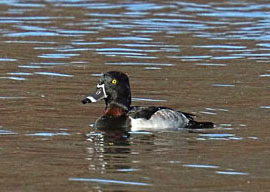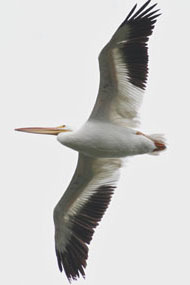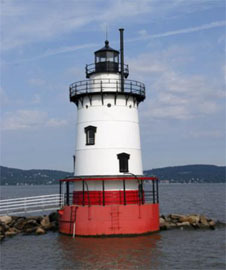Hudson River Almanac 11/16/15 - 11/22/15
The New York State Department of Environmental Conservation sent this bulletin on 11/28/2015 09:05 AM EST |
| DEC Delivers - Information to keep you connected and informed from the NYS Department of Environmental Conservation |
| Share or view as a web page || Update preferences or unsubscribe |
|
|
|
This was a quiet week of migrating birds, a few late-season fishes headed to the sea, rather mild autumn weather, and building anticipation for this year’s Christmas Bird Counts! HIGHLIGHT OF THE WEEK 11/21 - New Paltz, HRM 78: Alerted by a passing neighbor, we turned to see a young red-tailed hawk perched at eye level and only 30 feet away in our leafless dogwood, a freshly-caught, plump vole hanging from its talons. After a few cursory looks our way, the hawk started tearing off pieces of the rodent and gulping them down. Meal finished, it wiped its hooked beak on the branch a few times, looked at us again, and then moved closer, to another branch in the dogwood. Curious, it then flew even nearer, to a limb in a white pine overhead, and finally to a branch only ten feet above our heads. We stood motionless as it stared down, studying us with one eye, then the other, then with both. After two minutes of this, its assessment complete, the red-tail launched off on other business, while we wondered what it made of us. NATURAL HISTORY NOTES 11/16 - Hudson Valley: The Christmas Bird Count (CBC), the nation’s longest running citizen-science effort, is held throughout the country at year’s end. It replaced the Victorian era “side-shoot,” in which guests organized into sides went out to shoot as many different bird and mammal species as possible on Christmas Day. In 1900, ornithologist Frank Chapman organized a group of friends to observe, count and share information about bird species without shooting them. The National Audubon Society, which Chapman helped organize, now sponsors this annual tradition. Thousands of people go out to count and publish as many bird species as their group can in a sporting, competitive way. The result has been the gathering of significant data that has monitored changes in bird populations and distribution over the years. [For details on this year’s 116th annual Christmas Bird Counts in your area, December 14 through January 5, go to: http://www.nybirds.org/ProjCBC.htm. Carena Pooth, New York State Ornithological Association.]
[The male ring-necked duck does have a brown ring around its neck, as shown in Terry Hardy's photo. However, unlike the white ring around a mallard's neck, the ring is hard to see in all but the most ideal lighting conditions, and is seldom if ever listed as a field mark useful in identification. Steve Stanne.] 11/16 - Saratoga County, HRM 164: This was Day 113 for the gray seal that we believe remains in the Hudson River above tidewater despite no sightings in a month. There are still several commercial barges upriver that have to be “locked through” before the Lock One closes for the season. Tonight I watched one go through in the dark. Thinking of the gray seal, he might have heard the lock operating and may have gone through, headed down river on this night or another, completely undetected. 11/16 - Bedford, HRM 35: It was a complete turn-around from yesterday (107 raptors and vultures) at the Chestnut Ridge Hawkwatch with very little being seen (only ten birds). We did spot a few migrating red-shouldered and red-tailed hawks. Non-raptor observations included an eastern bluebird. 11/17 - Town of Wappinger, HRM 67: We spotted a large flock of cedar waxwings in the trees behind our house this morning. By this afternoon, some of them had moved to our water dish and bird bath, along with several robins. This was the first of them we had seen this fall and we assumed they were passing through, just stopping for some easy pickings. 11/17 - Hudson Highlands, HRM 45: As my early morning Metro North commuter train to Manhattan passed by across the river from Iona and Round islands, I counted three adult bald eagles evenly spaced in white pines along the shore. They were taking in the warmth from sunrise just south of Anthony’s Nose, a prominent peak in the Hudson Highlands. [In the 1980s, when bald eagles were still uncommon, Iona and Round islands - closed in the winter as a sanctuary - were the go-to places to see them. We conducted weekend programs at first light across the river at a lookout on Route 6/202 and would be thrilled to see one or two birds across several hours. Today, a day trip along the river in winter can result in sighting as many as a hundred bald eagles. Tom Lake.] 11/17 - Croton Bay, HRM 34-33: As my train passed by Croton Bay, the exposed sand bars gave evidence that it was low tide. For nearly a mile, there were dozens of discreet rafts of ducks: scaup, buffleheads, ruddy ducks, ring-necked ducks, black ducks, and some I could not identify in the early light, as well as hundreds of Canada geese strewn along the inshore shallows. Keeping pace with the train was an immature bald eagle and it was a bit surprising that there was no panic among the ducks and geese. On many other occasions, there would have been an explosion of wings as the waterfowl rose to escape. This eagle was conveying a message that it was not on the hunt. 11/17 - Sleepy Hollow, HRM 28: The trees along the river leading out to the Tarrytown Lighthouse were filled with various warblers and kinglets, Kingsland Point is a prime “jumping off” spot for songbirds in migration, after they rest for the long trek across the Tappan Zee to Rockland County. 11/17 - Bedford, HRM 35: A slow morning turned into a relatively busy afternoon at the Chestnut Ridge Hawkwatch. An adult bald eagle was seen with an immature to the east in midday. The immature was continually dive bombing the adult, resulting in a great aerial display. Shortly after, an immature golden eagle was spotted in almost in the same location. Non-raptor observations included 29 Canada geese and a common loon.
[White pelicans are a bird of the Great Plains on up through central Canada. While every year or so, one or more turn up somewhere in the Northeast, they are a rare sighting in the watershed. Pelicans are strong flyers with the ability to soar at great heights, covering long distances. Their presence here generally occurs when blown off course either in migration or drawn here from the Great Lakes area by nor’easters. Rich Guthrie.] 11/18 - Catskill Mountains, HRM 118: My trail camera captured an image of a bobcat that, with both the size (large) and coloring (tawny brown), could be initially mistaken for a mountain lion. This is especially true with all the mountain lion rumors that float around. However, the bobbed tail and spotting on the inside of its legs gave it away. I'd like to think that mountain lions could make a comeback. Our coyotes certainly have! The amount of coyote scat I encounter walking in the woods is ridiculous. 11/18 - Bedford, HRM 35: Most of the activity at the Chestnut Ridge Hawkwatch occurred when the clouds cleared in mid-morning. An immature bald eagle hung around to the southeast, occasionally harassed by a raven. A kettle of 30 turkey vultures (season total 2,614) was spotted to the south as well as a few more red-shouldered and red-tailed hawks. It was nice to see a merlin as well. Non-raptor observations included 90 American robins and a common raven. 11/18 - Sleepy Hollow, HRM 28: I was on my way to meet an class of elementary school students at the Tarrytown Lighthouse when a peregrine falcon flushed from a tree and rocketed past, headed toward the Tappan Zee Bridge. Any time or any place I see one of these magnificent animals, I feel exhilarated. 11/19 - Manhattan, HRM 1: We caught three young-of-the-year [YOY] striped bass 90 millimeters [mm] long this week in our fish traps at The River Project’s sampling site on Pier 40 in Hudson River Park. [This was not surprising since fisheries research conducted during the Westway debate (1971–1985) indicated that the west side of Manhattan was an important wintering area for immature striped bass. “Westway” was a 12-lane super highway proposed to be built on 200 acres of landfill in the Hudson River along the West Side of Manhattan. The project was abandoned in 1985. Tom Lake.]
[The Tarrytown Light, a five-story, round steel house reaching 55 feet above the water, was built 1882-1883 and commissioned on October 1, 1883. For 78 years the lighthouse’s bell and light protected river boats from the Tarrytown Shoals, inshore shallows that run six miles from Ossining to Tarrytown. The lighthouse became obsolete when the Tappan Zee Bridge was completed (1955); the lights from the bridge, 300 feet off the water, span the channel. The lighthouse was decommissioned in 1961 and in 1979 it was added to the National Register of Historic Places. Tom Lake.]
[“Moon tides,” also called spring tides, are associated with full and new moon phases and are more extreme – higher at high tide and lower at low. When coupled with onshore winds or storm surge, the river can rise far up on a beach, carrying floatables, or invade the river’s flood plain. Tom Lake.] 11/20 - Bedford, HRM 35: It was a slow day at the Chestnut Ridge Hawkwatch, with most of the birds moving through in the morning hours. Three very distant eagles were seen together to the east. Two were identified as bald eagles but the third was a mystery. Non-raptor observations included 40 Canada geese, two red crossbills, and three common ravens. 11/21 - Wappinger Creek, HRM 67: The lower mile of tidewater on Wappinger Creek was a busy place today. Three bald eagles were perched, spaced out over the distance, two of them immatures. In the reach between them were small groups of black ducks as well as assemblages of common merganser, mostly drakes, often dubbed “eagle food.” But on this day there was no panic among the waterfowl. The ducks must have sensed that the eagles were not hunting. [Eagle food? Diving ducks, such as mergansers, are more commonly targets of eagles than marsh ducks. While mallards, black ducks, teal, wigeon, pintails, and wood ducks spring straight up from the water, diving ducks such as mergansers, require a “runway” to get airborne, providing an easier target for eagles in a dive. Tom Lake.] 11/21 - Bedford, HRM 35: There was not much to be picked out from the blue sky today at the Chestnut Ridge Hawkwatch. There were a few turkey vultures and red-shouldered and red-tailed hawks, but little else. Non-raptor observations included ten gulls (species unknown) that were extremely high and acting like raptors. They rode the thermals and glided to the southwest. 11/22 - Saratoga County, HRM 184: Included in my survey of Loughberry Lake today were 850 ring-necked ducks, 350 Canada geese, 150 lesser scaup, 40 greater scaup, and six redhead ducks mixed in with scaup and ring-necks. 11/22 - Town of Wappinger, HRM 67: It was cool at midnight (38 degrees F) and fairly bright (three days to full moon), so the woods were a collection of gray shadows. Coyotes were on the prowl. I guessed at least three, maybe four. The acoustics of the night gave their yips and soft howls a surround-sound effect, but I knew they were not far off, just to west. Small mammals had to be on high alert. 11/22 - Bedford, HRM 35: There were very few birds moving today at the Chestnut Ridge Hawkwatch. An adult bald eagle (season total 99) was seen a few times in mid-morning to the south and east. HUDSON RIVER MILES The Hudson is measured north from Hudson River Mile 0 at the Battery at the southern tip of Manhattan. The George Washington Bridge is at HRM 12, the Tappan Zee 28, Bear Mountain 47, Beacon-Newburgh 62, Mid-Hudson 75, Kingston-Rhinecliff 95, Rip Van Winkle 114, and the Federal Dam at Troy, the head of tidewater, at 153. The tidal section of the Hudson constitutes a bit less than half the total distance – 315 miles – from Lake Tear of the Clouds to the Battery. Entries from points east and west in the watershed reference the corresponding river mile on the mainstem. TO CONTRIBUTE YOUR OBSERVATIONS OR TO SUBSCRIBE Smartphone app available for New York outdoor enthusiasts! Copies of past issues of the Hudson River Almanac, Volumes II-VIII, are available for purchase from the publisher, Purple Mountain Press, (800) 325-2665, or email purple@catskill.net |


 11/16 - Saratoga County, HRM 184: It seemed like a few more ducks crammed into Loughberry Lake each time I looked. I would guess that a large number of ducks spend several weeks here. A pair of wigeons has been working the shoreline for at least four weeks. Ring-necked ducks have steadily increased in number. Included in my survey were 900 Canada geese, 800 ring-necked ducks, 10 greater scaup, and 40 lesser scaup. [Photo of male ring-necked duck courtesy of Terry Hardy.]
11/16 - Saratoga County, HRM 184: It seemed like a few more ducks crammed into Loughberry Lake each time I looked. I would guess that a large number of ducks spend several weeks here. A pair of wigeons has been working the shoreline for at least four weeks. Ring-necked ducks have steadily increased in number. Included in my survey were 900 Canada geese, 800 ring-necked ducks, 10 greater scaup, and 40 lesser scaup. [Photo of male ring-necked duck courtesy of Terry Hardy.] 11/17 - Queens, New York City: Ed Becher came upon at a white pelican on the East Pond at the Jamaica Bay Wildlife Refuge. [Photo of white pelican by Robert Burton, courtesy U.S. Fish and Wildlife Service.]
11/17 - Queens, New York City: Ed Becher came upon at a white pelican on the East Pond at the Jamaica Bay Wildlife Refuge. [Photo of white pelican by Robert Burton, courtesy U.S. Fish and Wildlife Service.] 11/19 - Sleepy Hollow, HRM 28: My class of second grade students from Byram Hills was already impressed by the Tarrytown Lighthouse but as we stepped out onto the bell deck they were in absolute awe by the sight of a large bird hovering overhead. When it circled around and dropped closer into the light, its white head and tail flashed: an adult bald eagle, the first any of them had ever seen in the wild. Having provided a never-to-be-forgotten experience for the students, the eagle turned and headed up the river. [Photo of Tarrytown Lighthouse courtesy of Tom Lake.]
11/19 - Sleepy Hollow, HRM 28: My class of second grade students from Byram Hills was already impressed by the Tarrytown Lighthouse but as we stepped out onto the bell deck they were in absolute awe by the sight of a large bird hovering overhead. When it circled around and dropped closer into the light, its white head and tail flashed: an adult bald eagle, the first any of them had ever seen in the wild. Having provided a never-to-be-forgotten experience for the students, the eagle turned and headed up the river. [Photo of Tarrytown Lighthouse courtesy of Tom Lake.] 11/20 - Kowawese, HRM 59: Recent moon tides had left a debris line 40 feet up on the beach, but today’s early-morning river was calm and the tide was at ebb. The warm air (61 degrees Fahrenheit) convinced us that autumn had not left, and making one final haul of our seine seemed worth the effort. Our net captured residents such as tessellated darters (55-65 mm), spottail shiners (70-100 mm), and pumpkinseed (145 mm), but in the back of the bag was the prize: six YOY American shad (89-93 mm). The river was still a tepid 54 degrees F. [Photo of YOY American shad courtesy of Tom Lake.]
11/20 - Kowawese, HRM 59: Recent moon tides had left a debris line 40 feet up on the beach, but today’s early-morning river was calm and the tide was at ebb. The warm air (61 degrees Fahrenheit) convinced us that autumn had not left, and making one final haul of our seine seemed worth the effort. Our net captured residents such as tessellated darters (55-65 mm), spottail shiners (70-100 mm), and pumpkinseed (145 mm), but in the back of the bag was the prize: six YOY American shad (89-93 mm). The river was still a tepid 54 degrees F. [Photo of YOY American shad courtesy of Tom Lake.]